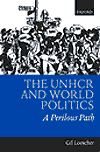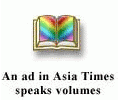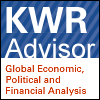| |
BOOK REVIEW
A history of helping the
displaced
The UNHCR and World Politics: A Perilous Path, by
Gil Loescher
Reviewed by Sreeram Chaulia
 Gil
Loescher can lay claim to the honor of writing the first
definitive history of the world's premier refugee organization,
the Office of the United Nations High Commissioner for Refugees
(UNHCR). Moreover, it is history with a difference. Instead of
merely recording the past, UNHCR and World Politics also
launches into a critical prescriptive analysis for the future of
the organization that was originally meant to be an ad hoc
answer to a temporary malaise affecting post-World War II
European refugees. Gil
Loescher can lay claim to the honor of writing the first
definitive history of the world's premier refugee organization,
the Office of the United Nations High Commissioner for Refugees
(UNHCR). Moreover, it is history with a difference. Instead of
merely recording the past, UNHCR and World Politics also
launches into a critical prescriptive analysis for the future of
the organization that was originally meant to be an ad hoc
answer to a temporary malaise affecting post-World War II
European refugees.
It is at one level the story of how a UN agency perpetuated
itself to remain in existence as long as there is violent
conflict in a world between nation-states, and at another level
a highly opinionated discourse on what has been wrong with the
UNHCR and how amends can be made to make it more responsive and
effective to its constituency of nearly 20 million refugees and
other people of concern.
Loescher, a 20-year veteran of refugee studies who has worked in
the corridors of UNHCR, has a prolegomenon-cum-justification for
authoring this book: Lack of cogent institutional memory is a
serious lacuna in the organization, and Loescher hopes that this
journey down memory lane will help instill a sense of the policy
evolution and direction, and political constraints that have
governed the Office in the last 50 years. Being an
intergovernmental organization, UNHCR maintains a "perilous
balance between the protection of refugees and the sovereign
prerogatives and interests of states", by projecting refugee
rights norms into a system dominated by concerns of national
interest and security. The extent to which powerful states
dictate to UNHCR and the extent to which successive high
commissioners have skillfully manuevered to maintain
independence within limits is the leitmotif of the book.
Cold War origins under Goedhart (1951-56)
UNHCR's early freedom was circumscribed by Cold War politics.
The USSR accused the organization of acting as a cover for the
Western bloc to engineer defections and plant spies in Eastern
Europe, and subsequently boycotted it. The deliberation and
drafting of the 1951 Refugees Convention were conducted solely
by Western powers and non-communist member states of the UN. The
convention "was intended to be used by the Western states in
dealing with arrivals from the East, and largely reflected the
international politics of the period". (p 45)
Ironically, the US government remained opposed to the UNHCR in
its first few years, beginning with the defeat of the American
candidate for the post of high commissioner. Washington funded
rival organizations and treated UNHCR as a "sideshow and a
mostly irrelevant organization".
The tide turned by 1955, with the Nobel Peace Prize awarded to
UNHCR and American representatives assuming active roles in
UNHCR's executive committee. Soviet attempts at "re-defection"
of refugees in Austria also raised US funding for UNHCR's local
integration solution.
Independence and expansion under Lindt and Schnyder (1956-65)
Under Swiss diplomat Auguste Lindt, "UNHCR's orientation became
clearly pro-American". (p 81) US government financial and
diplomatic backing of UNHCR operations rose to great heights
during the Soviet invasion of Hungary, when the international
community specifically designated UNHCR as the "lead agency" to
oversee a large-scale humanitarian emergency. Simultaneously,
Lindt displayed independent action by persuading Western states
that the repatriation of Hungarian minors in the interests of
family unity must take precedence over Cold War calculations;
this action earned the respect of the socialist governments of
Yugoslavia and Hungary.
At the turn of the decade, the US identified some refugee
programs outside Europe as affecting its strategic interests by
being sources of possible communist subversion and "encouraged
the High Commissioner's office to get involved in these
situations". (p 91) UNHCR "good offices" were used to mount big
operations for Chinese refugees in Hong Kong and Tibetans in
India, setting precedents for UNHCR intervention in refugee
assistance throughout the developing world.
In the 1960s, UNHCR increased its range of services in Africa,
gaining the trust and dependence of newly independent countries
on the continent. Under Felix Schnyder (another Swiss diplomat),
UNHCR changed the approach of assistance by providing
reintegration and reconstruction assistance to returnees in
Algeria. Lindt favored material assistance over legal protection
in terms of UNHCR priorities, leading some protection advisers
in the organization to complain that "most African countries
sought UNHCR involvement only for the money". (p 119)
More visionary than the previous two high commissioners,
Schnyder expanded the "good offices" concept with missionary
zeal, taking the plunge into uncharted waters like non-mandate
Laotian refugees in Cambodia, rural resettlement programs in
southern Africa, and acting as a "drop of oil" that would
attract other specialized UN agencies to refugee development.
He also allowed UNHCR to be used as "the perfect cover for US
policymakers" in the Sudan, where Washington was mindful of not
upsetting the government by aiding refugees emerging from the
south of the country. Likewise, "well aware of its limited
resources and mindful of following a policy that would put it in
conflict with a major power", Schnyder took no action in the
Cuban asylum crisis. (p 133)
The golden era under Aga Khan (1965-77)
Under the Iranian Sadruddin Aga Khan, UNHCR "shed its image of
being a tool of the United States and gained credibility as an
independent global actor". (p 141) His election was opposed by
the Americans on grounds that he was "Afro-Asian oriented" and
would neglect the Cold War escapees in Europe. True to
prediction, Sadruddin creatively extended UNHCR's mandate to
Sudanese in "refugee-like situations", ie, returnees and
internally displaced persons (IDPs), while staying away from
sensitive IDP cases like Indonesia and Nigeria.
From a lead agency, UNHCR moved to becoming the "focal point" in
the gargantuan Bangladesh operation, coordinating the United
Nations Children's Fund (UNICEF), the World Health Organization
(WHO), the World Food Program (WFP) and a bevy of
non-governmental organizations (NGOs). When Idi Amin expelled
Asians from Uganda in 1972 or when Pinochet's terror machine
created Brazilian and Argentinian refugees, Sadruddin was
careful to maintain good working relations with the governments
and at no time did he publicly condemn their inhuman actions,
again drawing protests that legal protection and human rights
were being sidelined by UNHCR. "Reluctance to criticize
governments for their human rights policies remained a
cornerstone of UNHCR policy until the 1990s." (p 175)
Problems galore under Hartling (1977-85)
Danish politician Poul Hartling, the new high commissioner, "did
not maintain a healthy independence from the United States,
unlike Sadruddin". (p 202) The bargain for losing freedom was a
quintupling of the UNHCR's budget from Western states, and
thanks to ample donor funding, even greater priority was given
to material aid and physical care rather than protection.
While forcefully arguing on behalf of Vietnamese boat people
fleeing the communist regime, Hartling was non-vocal about the
genocide committed by the Khmer Rouge in Cambodia and the
massive rejection of Cambodians by Thailand and Rohingyas by
Burma in 1978-79 (both Cambodia and Thailand were US allies at
the time).
Civil wars fought under the banner of the "Second Cold War" in
Afghanistan, Angola, Nicaragua, etc, led to the new problem of
refugee camp militarization, with internal UNHCR reports
lamenting that "humanitarian aid actually contributed to
prolonging conflict", but no action was taken to remedy this
dilemma that would continue into the 1990s. Widespread
proscription and rights abuses that took place in Afghan camps
in Pakistan were ignored and left to the excesses of
fundamentalist Islam and Western interests.
Touching rock bottom under Hocke and Stoltenberg (1986-91)
Upset that UNHCR might be veering towards a "legalistic"
approach, the US campaigned for a new "operational" high
commissioner, Jean-Pierre Hocke, the Swiss ICRC official.
However, Hocke's term "tore apart the UNHCR, drastically lowered
morale, and subjected the Office to international humiliation".
(p 249)
Downgrading of the UNHCR's legal culture reached its nadir,
leading NGOs and many UNHCR personnel to complain that the
new-look organization had "lost its soul". Hocke's promotion of
repatriation as the "only viable solution" even in conflict
zones, using subtle coercion and misinformation on refugees, was
widely resented within and outside. The only significant
achievement of Hocke was to anticipate the end of the Cold War
and negotiate the entry of countries from the Eastern bloc to
sign on to the 1951 Convention and join UNHCR.
Several financial crises overtook Hocke's last years, muddled by
allegations of personal corruption and declining Western
contributions. His pro tempore replacement, Norwegian Thorvald
Stoltenberg, improved the Office's relations with donors in the
executive committee, and during his short tenure he also
suggested policy shifts toward helping governments transport
non-refugees back home and preventing future migration flows.
New challenges under Ogata (1991-2000)
Sadako Ogata, the Japanese professor and diplomat, "proved to be
an enterprising entrepreneur and showed a sophisticated
awareness of the political opportunity structures within which
the UNHCR operated". (p 273) As the ultimate "practical HC", she
did not believe in lecturing governments or directly accusing
them of improper behavior. The end of the Cold War pushed her to
assume the role of "teacher of refugee norms" in Russia and the
former Soviet states, furthering the reach of the international
refugee regime.
Voluntary repatriations were successfully carried out to
Cambodia and Mozambique, even though the law was diluted to read
that UNHCR would encourage returns if conditions in home
countries improved "appreciably", not the original
"substantially". A structure of emergency response teams was
introduced in UNHCR to pre-position for imminent displacement
crises, and public information and visibility of the
organization in visual and print media was sharpened (Time
magazine, for example, invented the phrase "Ogata's Angels" for
UNHCR staff working in difficult conditions).
Ogata also opened internal and UN-wide debates on preemptive
action, such as not waiting for refugees to cross borders before
taking action. "Preventive protection" failed in Bosnia and
barely succeeded in southern Somalia. As one writes, clarity and
predictability of UNHCR response to IDP flows are still prisoner
to state stipulations and inter-agency politics.
The post-genocide refugee explosion from Rwanda and
militarization of camps were colossal failures that "constituted
a dereliction of responsibility and moral negligence" of the
Office. (p 313) UNHCR advocacy for asylum-seekers in "Fortress
Europe" was also minimal, with Ogata not keen on losing regained
confidence of donors by upsetting them. American and Australian
detention centers for asylum applicants also went unaddressed by
UNHCR.
The subservience of protection to operations received a coup de
grace with the internal restructuring of Project Delphi. Close
cooperation between the North Atlantic Treaty Organization and
UNHCR in Albania and Macedonia after the Kosovo war also
attracted widespread condemnation as compromising the
impartiality and independence of the Office. Russian policies in
Chechnya were not criticized although they caused immense
hardships and displacement. African refugees also passed below
the radar of UNHCR attention.
Conclusion
Loescher's main deduction from the evolutionary history of UNHCR
is that the imbalance between protection and material operations
threatens the raison d'etre of the Office and should be promptly
redressed. Though the Office is a "highly political actor
clearly shaped by the interests of major governments", it must
show "courage and a willingness to confront governments when
necessary". (p 367)
UNHCR's "culture of defensiveness" that impedes learning, debate
and innovation are also areas for change. Loescher alleges that
UNHCR is unaccountable to its constituency, refugees, as is
evident in numerous contrived repatriation policies.
Bureaucratic mentality is blamed for this undemocratic trait,
though Loescher has no concrete suggestions on how refugees can
be made more participative in policymaking. He also dwells upon
the financial crunch but lacks recommendations on broadening
private sector partnerships or other innovative methods to
ensure a steady flow of income to the organization.
Last but not least, Loescher advises UNHCR to practice
"listening and taking in the views of others and not just
pronouncing its own positions and opinions". (p 376) From this
author's recent stint at UNHCR, it is evident that openness to
scholarly and external views is slowly gaining ground, though it
is difficult to predict whether any "Lessons Learned" are being
imbibed in the process.
A complete book in many senses, Loescher could have renamed it
A US-UNHCR Saga, a la Boutros Ghali's controversial
memoir. For an intimate account of American stewardship,
influence and leverage on a UN body, read this book.
The UNHCR and World Politics: A Perilous Path, by
Gil Loescher. Oxford University Press, 2001. ISBN 0-19-924691-2.
Price US$21.95. 431 Pages)
(©2002 Asia Times Online Co, Ltd. All rights reserved. Please
contact
[email protected] for
information on our sales and syndication policies.)
|
| |
|
|
 |
|




 Gil
Loescher can lay claim to the honor of writing the first
definitive history of the world's premier refugee organization,
the Office of the United Nations High Commissioner for Refugees
(UNHCR). Moreover, it is history with a difference. Instead of
merely recording the past, UNHCR and World Politics also
launches into a critical prescriptive analysis for the future of
the organization that was originally meant to be an ad hoc
answer to a temporary malaise affecting post-World War II
European refugees.
Gil
Loescher can lay claim to the honor of writing the first
definitive history of the world's premier refugee organization,
the Office of the United Nations High Commissioner for Refugees
(UNHCR). Moreover, it is history with a difference. Instead of
merely recording the past, UNHCR and World Politics also
launches into a critical prescriptive analysis for the future of
the organization that was originally meant to be an ad hoc
answer to a temporary malaise affecting post-World War II
European refugees. 










